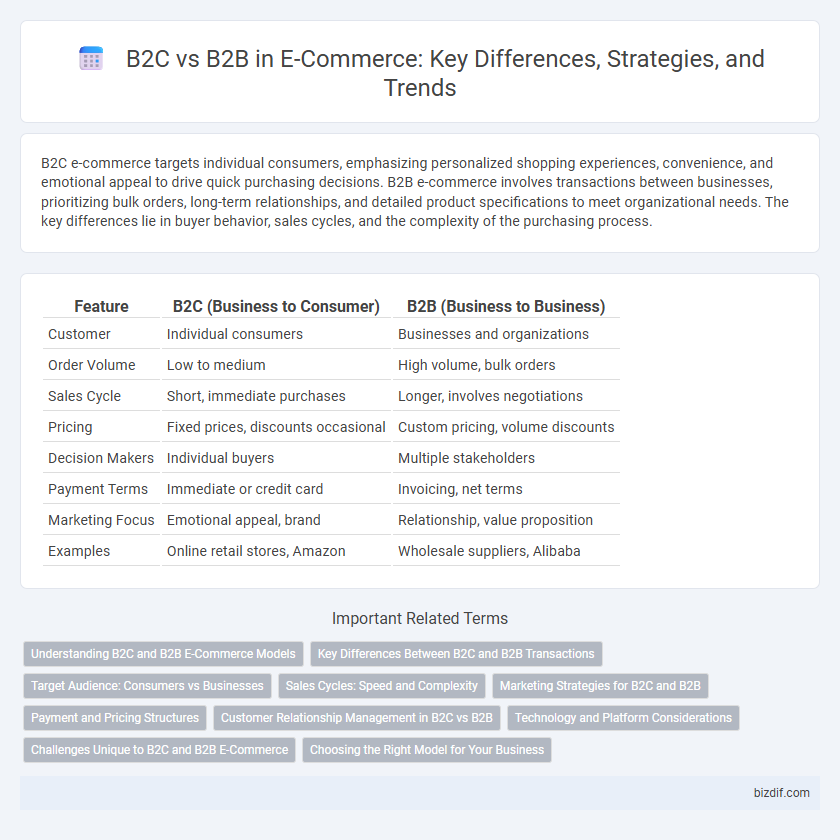B2C e-commerce targets individual consumers, emphasizing personalized shopping experiences, convenience, and emotional appeal to drive quick purchasing decisions. B2B e-commerce involves transactions between businesses, prioritizing bulk orders, long-term relationships, and detailed product specifications to meet organizational needs. The key differences lie in buyer behavior, sales cycles, and the complexity of the purchasing process.
Table of Comparison
| Feature | B2C (Business to Consumer) | B2B (Business to Business) |
|---|---|---|
| Customer | Individual consumers | Businesses and organizations |
| Order Volume | Low to medium | High volume, bulk orders |
| Sales Cycle | Short, immediate purchases | Longer, involves negotiations |
| Pricing | Fixed prices, discounts occasional | Custom pricing, volume discounts |
| Decision Makers | Individual buyers | Multiple stakeholders |
| Payment Terms | Immediate or credit card | Invoicing, net terms |
| Marketing Focus | Emotional appeal, brand | Relationship, value proposition |
| Examples | Online retail stores, Amazon | Wholesale suppliers, Alibaba |
Understanding B2C and B2B E-Commerce Models
B2C e-commerce caters directly to individual consumers, emphasizing user-friendly interfaces, personalized marketing, and swift transaction processes to enhance customer experience. B2B e-commerce involves transactions between businesses, often characterized by larger order volumes, negotiated pricing, and integration with supply chain management systems. Understanding these models enables businesses to tailor their strategies effectively, optimizing sales channels and customer relationships.
Key Differences Between B2C and B2B Transactions
B2C transactions typically involve individual consumers purchasing products for personal use, characterized by shorter sales cycles, lower order values, and emotional purchasing decisions. B2B transactions focus on business clients buying goods or services for operational needs, featuring longer sales cycles, higher order values, and complex negotiation processes. Payment methods and marketing strategies also differ, with B2C relying on quick, user-friendly interfaces while B2B demands customized solutions and relationship management.
Target Audience: Consumers vs Businesses
B2C e-commerce targets individual consumers who seek personal products and an engaging, user-friendly shopping experience. B2B e-commerce caters to businesses requiring bulk orders, specialized pricing, and streamlined procurement processes. Understanding these distinct target audiences helps optimize marketing strategies and platform functionalities for each segment.
Sales Cycles: Speed and Complexity
B2C sales cycles are typically shorter and more straightforward, driven by individual consumer decisions and immediate needs, resulting in faster transaction times. In contrast, B2B sales cycles are longer and more complex due to multiple stakeholders, extensive negotiations, and customized solutions, requiring ongoing relationship management. E-commerce platforms must adapt to these differences by optimizing user experience for quick purchases in B2C and providing detailed product information and communication tools for B2B buyers.
Marketing Strategies for B2C and B2B
B2C marketing strategies prioritize emotional engagement, personalized content, and seamless user experiences to drive quick purchases from individual consumers. In contrast, B2B marketing targets decision-makers through detailed product information, relationship building, and lead nurturing via content marketing and account-based marketing (ABM). Leveraging data analytics and customer segmentation enhances both B2C and B2B campaigns by maximizing relevance and conversion rates.
Payment and Pricing Structures
B2C e-commerce typically features fixed pricing and streamlined payment options such as credit cards, digital wallets, and buy-now-pay-later services to enhance consumer convenience. B2B transactions often involve negotiated pricing, volume discounts, and extended payment terms like net-30 or net-60 invoices to accommodate larger order volumes and cash flow considerations. Payment methods in B2B e-commerce commonly include purchase orders, bank transfers, and credit lines, reflecting the complexity and scale of business purchases.
Customer Relationship Management in B2C vs B2B
Customer Relationship Management (CRM) in B2C e-commerce emphasizes personalized marketing, customer engagement, and loyalty programs to enhance individual consumer experience and increase repeat purchases. In contrast, B2B CRM prioritizes long-term relationship building, account management, and tailored solutions to meet the complex needs of business clients. B2B systems often integrate with ERP and supply chain platforms, enabling seamless communication and efficient order management, while B2C CRM focuses on data analytics and customer segmentation to drive targeted campaigns.
Technology and Platform Considerations
B2C e-commerce platforms prioritize user-friendly interfaces, mobile responsiveness, and personalized marketing technologies to drive high-volume, individual consumer sales. B2B solutions emphasize robust ERP integrations, scalable inventory management, advanced payment options like purchase orders, and security protocols to support complex transactions between businesses. Effective technology selection ensures seamless order processing, customer relationship management, and data analytics tailored to either B2C or B2B market demands.
Challenges Unique to B2C and B2B E-Commerce
B2C e-commerce faces challenges including high customer acquisition costs, rapidly changing consumer preferences, and the demand for seamless, personalized shopping experiences. B2B e-commerce encounters complexities such as managing bulk orders, intricate pricing structures, and integrating with existing enterprise resource planning (ERP) systems. Both models require robust cybersecurity measures, but B2B transactions typically involve larger financial stakes and longer sales cycles, increasing the need for trust and reliability.
Choosing the Right Model for Your Business
Selecting the right e-commerce model, whether B2C (Business-to-Consumer) or B2B (Business-to-Business), depends on target audience, product type, and sales cycle complexities. B2C models emphasize rapid transactions and broad customer reach, optimized by user-friendly platforms and personalized marketing strategies. In contrast, B2B e-commerce prioritizes long-term relationships, bulk ordering, and customized pricing structures, benefiting from robust CRM integrations and scalable supply chain solutions.
B2C vs B2B Infographic

 bizdif.com
bizdif.com